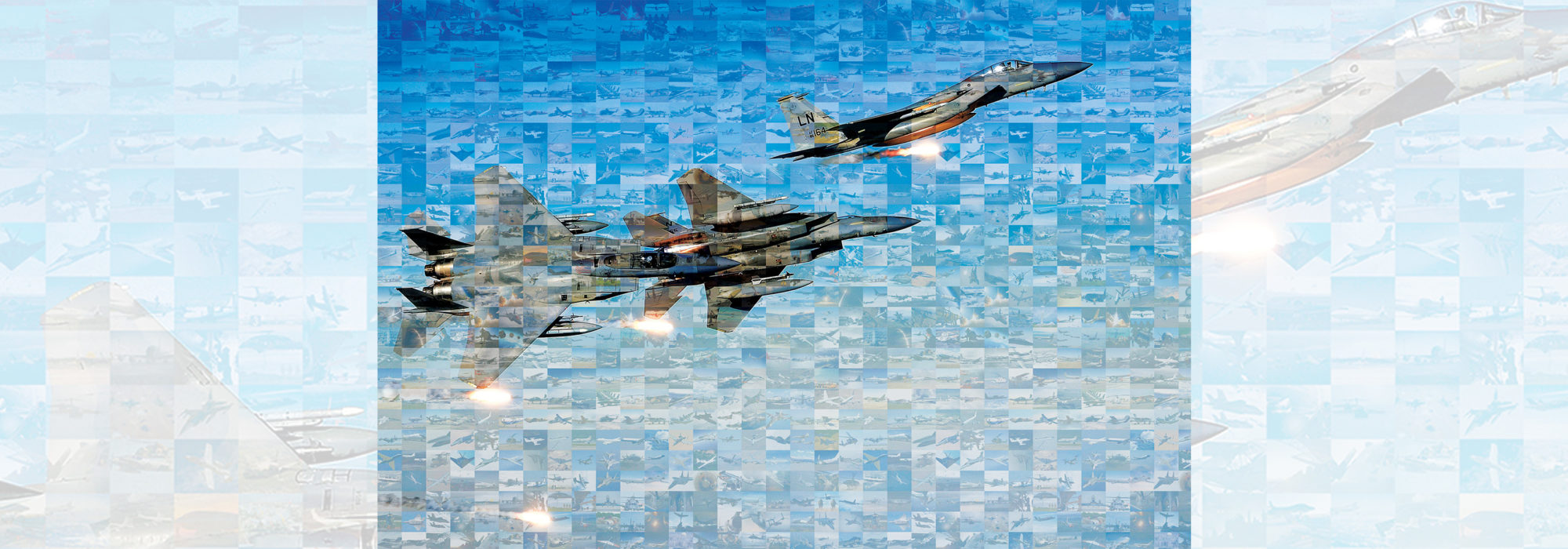
USAF’s last dedicated interceptor, “The Six” was optimized for speed, radar target detection and range, equipped with internal weapons. USAF

T-33 Shooting Star. Derived from the Korean-era F-80 fighter, the T-33 was used by more than 20 countries. As a full-scale target, it served USAF until 1997.
USAF

A-20 Havoc. A WWII holdover, the Havoc was used largely in the Pacific by the Army Air Forces. USAF

A-26/B-26 Invader. This WWII-era bomber proved highly effective at counterinsurgency in Vietnam and was used by the CIA at the Bay of Pigs invasion in Cuba. USAF

P-47 Thunderbolt. Later the F-47, the “Jug” of WWII served with the Air National Guard for years. The type was used against Puerto Rican nationalists in 1950. USAF

F-80 Shooting Star. USAF’s first operational jet fighter, the F-80 served in Korea as a dogfighter and attack aircraft. USAF

A-1 Skyraider. Developed for WWII, the Navy-designed “Spad” was a star at counterinsurgency in Vietnam and in helping recover downed airmen there. National Museum of the USAF

P-82 Twin Mustang. USAF’s last piston-engined fighter, the “Double Trouble” scored the first kills in Korea and served as a day/night interceptor. USAF

F-84 Thunderjet. The F-84 destroyed 60 percent of the ground targets attacked by air in Korea and was the first mount of the Thunderbirds aerial demo team. USAF

F-51 Mustang. The WWII-era Mustang’s agility and range made it ideal for close air support missions in Korea, flown largely by Guard and Reserve units. USAF

A U.S. Air F-84F Thunderstreak. A swept-wing upgrade of the straight-wing F-84, the Thunderstreak was a fighter-bomber in Korea, later serving in the Berlin crisis and ANG. USAF

F-86 Sabre. USAF’s first swept-wing jet fighter could outfly its counterpart in Korea, the Soviet MiG-15. Nearly 10,000 served in countries worldwide. Courtesy

F-86D Sabre Dog. A development of the F-86A, the Sabre Dog was larger, had afterburning engines, and a long-range radar, equipping it for interceptor missions. USAF

F-94 Starfire. A development of the F-80, and constantly upgraded, the F-94 served as an all-weather Air Defense Command interceptor during the 1950s. USAF

F-89 Scorpion. The twin-engined Scorpion was the first interceptor armed with guided missiles and the Genie, an unguided nuclear air-to-air missile. USAF

F-100 Super Sabre. The first USAF operational jet to fly supersonic in level flight, the F-100 earned its reputation in Vietnam as a fighter-bomber. USAF

F-102 Delta Dagger. The supersonic, delta-winged “Deuce” Air Defense interceptor also flew in Vietnam as a bomber escort and in a few ground-attack missions. USAF

F-101 Voodoo. The Voodoo was mainly an interceptor, but the RF-101 reconnaissance version played a key role in Vietnam and the Cuban Missile Crisis. USAF

F-104 Starfighter. Developed in two years, the “Missile With a Man in It” served in Vietnam and as an interceptor. Rocket-aided test models flew to the edge of space. Ken Hackman/USAF

F-105 Thunderchief. The “Thud” scored dogfight kills in Vietnam, but was mostly used as a bomb truck and a Wild Weasel defense suppression jet. Rick Diaz/USAF

F-4E Phantom II. Another Navy adaptation, the F-4C/D/E were USAF’s premiere fighters in Vietnam, also adapted to ground attack and fitted with guns. USAF

F-5E Tiger II. A development of the T-38 trainer, the F-5 served many years as USAF’s main “Aggressor” jet, emulating adversary aircraft like the MiG-21. USAF

OA-37 Dragonfly. Used for target marking and light attack, the OA-37’s bigger engines and underwing stores distinguished it from the T-37B trainer. USAF

A-7D Corsair II. Adapted from a Navy jet, USAF used the A-7 for precision attack of ground targets and close air support from the 1960s to the 1990s. USAF

F-111 Aardvark. Arising from a troubled joint fighter program, the F-111 evolved into a fine medium bomber used in wars from Vietnam to Iraq. Master Sgt. Patrick Nugent/USAF

AC-130 Ghostrider. Bristling with cannons, the AC-130 gunship variant of the Hercules transport orbits and watches an enemy, destroying vehicles and formations. James West/USAF

F-4G Wild Weasel. The F-4G used HARM missiles and jamming gear in Iraq to silence or destroy enemy air defense radars and missile systems. USAF

1976 A10 Thunderbolt II. Designed to stop 1970s Soviet tanks with its huge 30 mm gun and absorb damage, the A-10 has flown close air support for nearly 50 years. Master Sgt. William Greer

F-15A/C Eagle. Undefeated in air combat nearly 50 years after its rollout, the Eagle boasts triple-sonic speed and high maneuverability. Tech. Sgt. John McRell

F-16A/C. USAF’s “backbone” fighter since the 1980s, the F-16 has evolved from a day fighter to a multirole platform focused on ground attack and SEAD. USAF

F-117 Night Hawk. The world’s first operational stealth combat jet, the F-117 was a prodigy at destroying the most-heavily defended targets in Iraq and Serbia.
Staff Sgt. Derrick Goode

F-22 Raptor. Acknowledged as the world’s best-ever dogfighter, the F-22 combines stealth and supercruise with sensor fusion and extreme agility, aided by thrust-vectoring. Tech Sgt. Ben Bloker

F-15E/EX. Strengthened for heavy payloads, the Strike Eagle has conformal fuel tanks for longer range. The new EX features fly-by-wire flight controls. Ethan Wagner/USAF

The Air Force’s strike “quarterback,” due to its massive information-collection capability, the “Panther” is nevertheless a 9G fighter and a multirole attack jet which will be the backbone of the combat air forces for decades to come. Airman 1st Class Yosselin Perla

KC-97 Stratofreighter. Derived from the C-97, the KC-97 freighter/tanker expanded fighter range in Vietnam and served with the ANG well into the 1970s. USAF





























































































































































